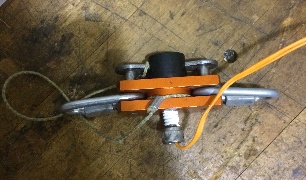...
The Tender descenders are used by the team for achieving a single separation dual deploy architecture. For most of our large rockets (including Hermes), we use the "L2" model of Tender Descender. The sales page can be found here: http://www.tinderrocketry.com/l2-tender-descender-tether
Width of opening/maximum diameter of line = .16 in.
Student Modifications
The Tender Descender currently used by Rocket Team has a hole drilled and tapped for a 1/4-20 bolt to screw in where the E-match is normally located. Our 1/4-20 bolts have holes drilled in them with E-match glued in–we call these "FireBolts." This allows us to screw our E-matches and secure them with Teflon tape.
Testing Campaign
Team Members are in the process of conducting tests to ensure that we understand proper Tender Descender operation and to verify our student modifications.
The first phase of testing was performed September 30, 2017. This was done in the blast chamber in the basement of Building 37. ~8 people showed up to help. Our goal was to simply test whether we could make a Tender Descender "pop". We measured out 0.2 grams of black powder and set up the wiring using the long spool of wire which is often used for ground tests. We found that we were unable to trigger the E-match. We switched to using a short (~25 feet) extension cord (meant for 120 VAC) as our trigger wire. This allowed the E-match to fire. For future tests, we need to either use short wires, or use more-capable batteries. A LiPo battery would need to be completely charged for us to be confident in its ability to trigger the E-match through the long wire.
Once we swapped the wiring, we were able to activate the Tender Descender. We had four FireBolts made beforehand, and had just consumed one. We decided to replicate our first test with 0.2 grams of black powder. The best scale we had was 0.1 grams of precision, which we found was not really sufficient to measure things out accurately. We tried lowering the charge to 0.1 grams, but it seemed like it was just as volumetrically full inside the "cup" of the Tender Descender, and upon triggering seemed like it may have even been more energetic than the 0.2 gram tests. For the final test, we decided to forgo the scale. We used a popsicle stick to pull one "scoop" out of the canister of black powder, to see if this minimal amount would be enough to fire the separation. We found that it was indeed successful. This indicates to us that even a small charge can activate the Tender Descender, and that our larger charges will not be "borderline" in ability to fire.
Setup and Operation Checklist
Materials Needed:
- Tender Descender
- Two Quicklinks (make sure they fit in the Tender Descender)
- Black Powder
- Safety Supplies
- Scale, weighing tray, popsicle stick
- Teflon Tape
- Scissors
- FireBolt (1 for each firing!)
- Isopropanol
- Wiping Rag
...
Procedure:
- If needed, clean the Tender Descender with isopropanol and the rag. This needs to be done after each firing to remove the spent black powder residue.
- Put the Tender Descender string through one of the Quicklinks so it stays attached to our stuff after firing
- Ensure Quicklinks are tightened - it will be hard to turn the nut after they're integrated.
- Put the two Quicklinks (one of which now has the string through it) into the Tender Descender
- Put the bridge piece into the Tender Descender, unifying all of the components that have been used so far.
- Using a funnel, pour the pre-measured black powder charge into the small hole in the base of the Tender Descender. Pour slowly to avoid the funnel clogging.
- Wrap ~5 turns of Teflon Tape around the FireBolt. Generally go a little light rather than a little heavy. If too much tape is on, the FireBolt may not be able to drive far enough into the body.
- Screw the FireBolt into the Tender Descender, finger-tight. You definitely don't want more than ~4 threads of screw to be exposed.
- Attach Tender Descender to rest of system. Unscrew the system's Quicklinks, not the Tender Descender's, because again, it's hard to undo the TD's Quicklinks.
- When connecting the E-match to the firing system, ensure that the wires are well-gapped to avoid shorts.
...
Testing Campaign
Team Members are in the process of conducting tests to ensure that we understand proper Tender Descender operation and to verify our student modifications.
| Date | Number of Tests | Results |
|---|---|---|
| September 30, 2017 | 3 | Proved out use of Firebolt |
| October 8, 2017 | 3 | Characterized response to different quantites of black powder |
| April 5, 2018 | 2 | Proved parallel configuration |
| November 9, 2018 |
In future tests, it may be interesting to attempt to fire a Tender Descender with no black powder at all (Potentially, the pyrogen in the E-match could be energetic enough to separate the components). More relevantly, it will be good to test the Tender Descender's ability to fire under load. This will involve suspending a weight from the quick-links of the Tender Descender, then seeing if it can separate. This will be a closer simulation to the in-flight configuration, where we will have a rocket descending under the drogue. All the tests thus far have been an isolated Tender Descender sitting on a table, which isn't as indicative of ability to perform in an actual falling rocket.
